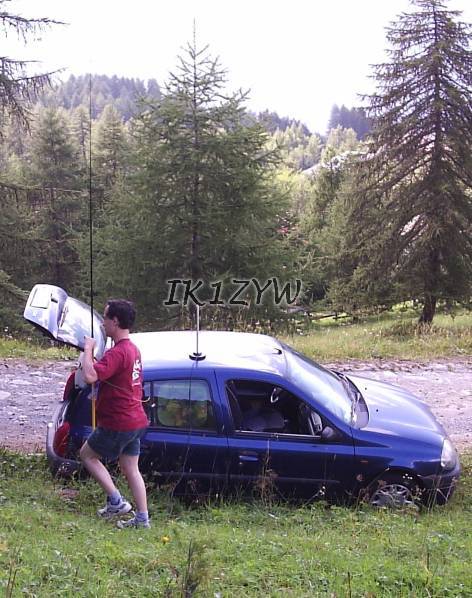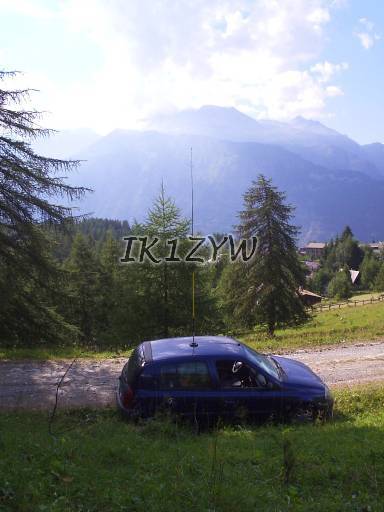
Figure 1: assembly instructions of antenna base
What for?
This page describes a self-supporting antenna for stationery-mobile HF operation, that requires no more than a pair of scissors and a knife to be built. It is composed of readily available materials and is compact enough to fit into the car. Last but not least, the antenna is a set of no-tuner monoband radiators, which exhibit an acceptable radiation pattern :-)
What is the antenna composed of?
Other hardware needed
Bands?
The overall length of my radiator support has turned out to be 3.3m: enough to hold a λ/4 wire for 2, 6, 10 and 12m.
15m theoretically needs 3.6m of radiator, which can be fit somehow to the fishing rod.
Lower bands necessarily need a loading coil to cancel the extra capacitive reactance offered by a short radiator.
A detailed per-band description will be added as soon as it has been tested.
How?
The complete antenna is composed of (bottom to top): magnetic base with PL-259, one SO-238, 20mm OD pipe, 16mm OD pipe, fishing rod; a wire from SO-PL up along the vertical support.
The trick for supporting the fishing rod lies in the fact that the 16mm OD pipe can be sled into the lower rod section. Moreover most (all?) fishing rods have a cap at their bottom that can be removed for maintainance purposes: unscrewing the cap will be an important step when installing the antenna on your car!
Step 0: buying materials
I was not able to buy PVC pipes and the fishing rod in the same shop, so you probably have to buy either first.
Given that the 20mm OD pipe fits properly on the outer part of a PL-259, I suggest to buy it first. While you are at it buy also the 16mm OD PVC pipe, and make sure it slides comfortably into the 20mm OD one. These pipes are found in the electrical corner of most hobby stores, at least 1m long.
Now it is time to get hold of a proper fiberglass fishing rod. Large sportswear stores usually stock a lot of these rods, and have cheap models as well. Make sure the one you're about to buy is actually made of fiberglass (cheaper that same-length carbon ones) and is telescopic. Then, hiding from the shop attendant :-), unscrew the cap at the bottom and verify that the 16mm OD PVC pipe slides into the lower rod section at least for 20cm.
I have reasons to believe that 3m &: 4m long telescopic fishing rods have the same base ID, so try that one too! If you buy a 4m fishing rod you'll have to experiment with radiator lengths and loading coils on your own.
Step 1: the lower support must be built.
Red text shows references to the drawing below.
Cut 20cm of the larger pipe, and take the outer sleeve of PL-259. Hold both with pliers: now you have to force the sleeve into the PVC pipe. Since the diamater difference is considerable, warm up the PVC pipe on the kitchen fire (don't keep the pipe too close to the fire!!!) and then force the sleeve inside until it is aligned to the pipe end. Steps 1a, 1b, 1c.
Now slide the smaller pipe into the larger from the opposite side of the PL-259 sleeve (2a). When it reaches the end, mark and then drill a 2-3mm hole a couple of centimetres above the end of the larger pipe (2b). I am sure the drawing shown below clarifies this process.
Finally pass your antenna wire through the hole towards what will be the lower end of the inner pipe (2c, 2d), and solder it to the PL-259 plug center pole (3). Leave about 10cm of wire sticking out of the smaller pipe, on the upper end (4).
Please note that the 2cm clearance is needed in order to allow the two pipes to slide when screwing the antenna to the base.

Step 2: monoband radiators follow.
My version of this antenna consists of a set of monoband radiators, so that a band change requires a change either in the radiator extension (6, 10, 12 and others) or the base loading coil (15, 17, 20, 30, 40, 80, 160m). Each radiator is an extension of the wire that sticks out of the PVC base, so you must take into account its length (about 30cm) when cutting wires.
2m: altought this band does not currently interest me, an extension radiator to reach λ/4 can be easily cut. Moreover the fishing rod provides enough length to build a 5/8th wave vertical, but you'd need to compute a base matching coil.
6m: you should have no troubles in cutting an extension that gives λ/4 somewhere between 50 and 51 MHz!
10m: 28.5MHz requires about 2.63m of radiator, so an extension of 2.33m should be used. Cut it longer and then shorten as needed!
12m: quarter wave at 24.9MHz is 3m; just cut an extension that reaches the top of your fishing rod and shorten as needed. Other bands will require loading coils.
General purpose extension: for other HF bands you'll need a loading coil. For practical purposes, and since it does not provide much extra gain (ehm, lower attenuation), I have chosen base-loading. Thus I cut an extension wire that covers the whole fishing rod, perhaps even the 12m extension does the trick!
I used leftovers of the 20cm OD white PVC pipe as coil supports.
15m: a 3.6m long radiator would be needed. Since we have only 3.3m, theoretically 5 turns are needed.
17m: add 5 more turns to the 15m coil and your antenna should resonate on this nice band. I wound both coils on the same support with a central tap.
20m: practical attempts and computer simulations show that about 21 turns are needed for the Queen DX band. On a 20mm OD pipe support I wound this coil as stand-alone and not as an extension of 17+15m.
30m: not built yet.
40m: I decided to keep the base-load mechanism. A center-loaded vertical of the same length is approx. 2dB better.
I encourage you to use an antenna analyzer for tuning extensions and loading coils: the whole process becomes fast and not annoying. Theoretical values or other people results just put you in the ballpark, then you need to refine your setup.
I soldered fast-on connectors on wire ends. I used black or white colors as a visual aid for matching the right connections: black on the coil is male, while black on the adapter is female; red on the coil is female, red on the radiator/extension is male.
Setting it up
Screw the adapter on the magmount base, and put it on the car. Extend the fishing rod and once it is secured unscrew the bottom cap. Tie the vertical radiator/extension at the proper point of the rod using some PVC tape. Insert the base of the road around the adapter, plug the desired coil and operate! Once extensions and coils are tuned, the antenna is setup in less than a minute.
REMEMBER: DO NOT MOVE THE CAR WHEN THIS ANTENNA IS INSTALLED!


